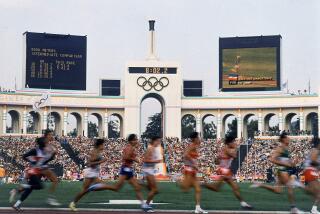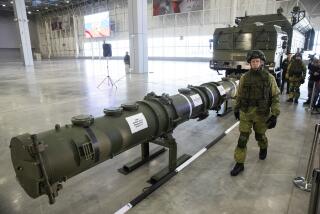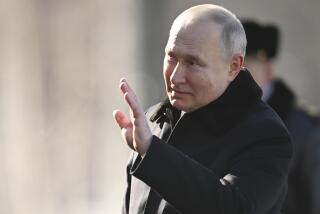It Was ‘Star Wars’ Muscle That Wrestled Arms Race to a Halt : START: The treaty couldn’t have happened without the U.S. defense buildup that came first.
As East and West celebrate the START treaty, this first step in the actual reversal of the arms race, it is instructive to remember how we got here.
The world looks very different today from the way it looked in 1982, when START negotiations began. Then, the Kremlin still seemed intent on expanding communism on a global scale. It was also spending nearly 30% of its gross national product on a non-stop arms buildup. The Soviet Union’s conventional forces were far more extensive than NATO’s, and its nuclear arsenal continued to grow.
The course of “arms limitation,” although it had many adherents in the United States, struck me as no longer being the correct one for us to follow. The SALT II treaty brought home clearly to me the fact that both sides had been negotiating the rate of growth of nuclear arms when they should have been negotiating reductions in these arsenals. When I became President in 1981, I was determined to see this change in priorities take place.
Modern history suggested strongly that the men in the Kremlin respected strength and exploited weakness. I was convinced that preemptive concessions on our part, with the hope they would coax responsive concessions from the Soviets, would not work. What was needed was the rebuilding of our national defense capability.
We set about to do just that, beginning in 1981, well before the initiation of START negotiations. In early 1983, I called for the development of a Strategic Defense Initiative (SDI) effective enough to stop a high percentage of incoming missiles from destroying our own arsenal in order to discourage an enemy from considering launching an attack in the first place.
Some “experts” committed to the old “arms limitation” concept criticized my Administration and me for pursuing this course. We knew, however, that the Soviets were spending such a large percentage of their national wealth on armaments that they were bankrupting their economy. We also knew that, if we showed the political resolve to develop SDI, the Soviets would have to face the awful truth: They did not have the resources to continue building a huge offensive arsenal and a defensive one simultaneously.
At the same time, in 1983, the West German government decided to proceed with deployment of cruise missiles, checkmating Soviet forces facing NATO in Europe.
Soviet negotiators in Geneva walked out and did not return until March, 1985, coinciding with Mikhail S. Gorbachev’s succession to leadership. A realist, Gorbachev had no illusions about the desperate condition of his country’s economy.
At our first summit meeting in Geneva that November, he and I agreed to a goal of 50% reductions in nuclear weapons on both sides. He argued strenuously, as he did at subsequent summits, for a delay in the development, testing and deployment of SDI. But that was one element on which we could not afford to budge, and I did not.
As we now know, Gorbachev concluded that the only practical thing was to embark on basic reforms at home, and without delay. Today, we see a Soviet Union undergoing fundamental change, politically and economically.
The final version of the START treaty will reduce nuclear warheads on U.S. missiles by about 39% and on Soviet missiles by 48%, close to the goal that Gorbachev and I set for ourselves.
There is, of course, more to do in both nuclear and conventional arms areas. However, a major arms-reduction treaty is a reality and U.S.-Soviet cooperation grows every day in a range of fields. This suggests that we may be closer to achieving “zero” nuclear weapons than anyone would have dared hope 10 years ago.
More to Read
Sign up for Essential California
The most important California stories and recommendations in your inbox every morning.
You may occasionally receive promotional content from the Los Angeles Times.










